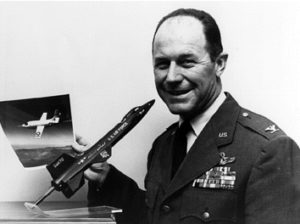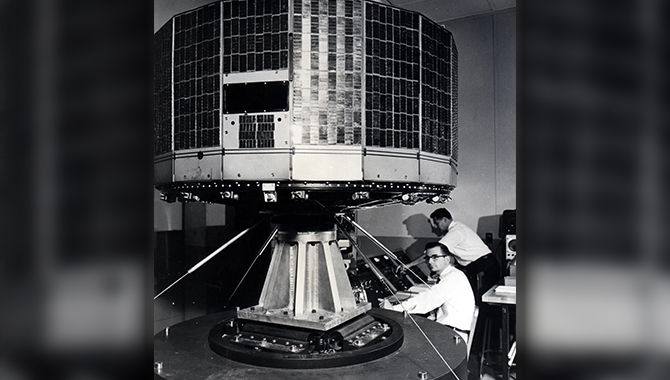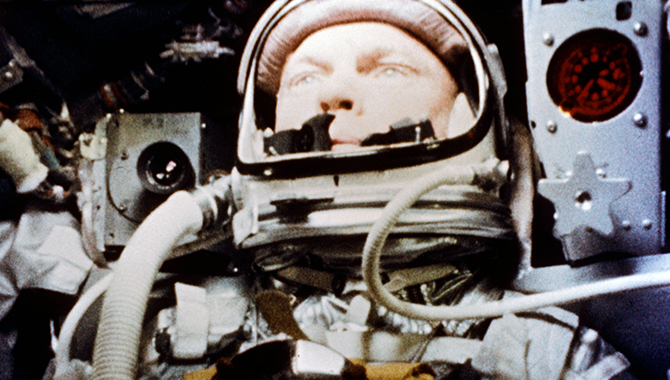
X-1E airplane being loaded under the mothership, Boeing B-29. A hydraulic lift elevated the launch aircraft and then lowered it over the rocket plane for mating.
Credit: NASA Photo / NACA/NASA
Crack in fuel tank ends storied research program at the dawn of the space age.
Sixty years ago this month, on November 6, 1958, test pilot John McKay dropped from the underside of a B-29 Superfortress in the experimental X-1E rocket plane. Although the plane had reached Mach 2.24 in earlier tests, this was to be a low-altitude/low-Mach test of a new propellant mixture of unsymmetrical dimthydrazine and diethylene triamine. The new fuel, coupled with engine modifications, was expected to eventually push the X-1E to significantly higher top speeds, approaching Mach 3.
Although the test was successful, the X-1E would never exceed its earlier top speed. Following the flight, an X-ray inspection revealed cracking in the fuel tank wall, which was a structural element of the small rocket plane. With more advanced planes, such as the X-15 rocket plane and the F-104 supersonic interceptor, already set to take its place, the X-1E was retired.

On October 14, 1947, Charles E. Yeager broke the sound barrier over the town of Victorville, California.
Credit: NASA
The X-1E is an unusual-looking plane by contemporary standards. The fuselage appears thick in profile, oval in cross-section, measuring just 31 feet long, tip to tail. The plane’s ultra-thin, high-strength straight wings form a span of 22 ft, 10 in. across. The plane weighs 14,750 pounds when fully loaded. Reaction Motors Inc. supplied the engine, an XLR11, one of the earliest liquid propellent rocket engines designed for a plane. The engine has four chambers, but no throttle. To reduce power, one or more of the chambers has to be turned off.
The X-1 was a joint program of NASA’s predecessor, the National Advisory Committee for Aeronautics, with the U.S. Army Air Forces, and the U.S. Air Force. The experimental planes were built by Bell Aircraft. Although swept wing designs would become the standard for the fastest planes in the decades to come, too little was known about their performance at the time, and the X-1 planes used straight wings.
The program pushed the envelope from its earliest days. U.S. Air Force test pilot Charles E. (“Chuck”) Yeager took the first X-1 plane faster than the speed of sound on October 14, 1947—the first level flight to break the sound barrier. Over the next decade, a long list of accomplished test pilots would push other iterations of the X-1 faster.
Although the X-1 planes were designed for conventional takeoff, they were almost always released in the air from the B-29 Superfortress bombers that were in plentiful supply following World War II. Early X-1s were hoisted into place with straps. Later, a hydraulic lift was used to raise the B-29. The X-1E was towed into place, the B-29 was lowered, and the X-1E was secured into the bomb bay with belly straps.

Test pilot Joseph A. Walker flew the X-1E to Mach 2.24 in 1957. Walker would go on to fly the X-15 rocket plane beyond the Kármán line.
Credit: NASA
The X-1E was a modified version of an earlier plane, the X-1-2. In early X-1 planes, pilots entered and exited through a cumbersome side hatch. The X-1E has a canopy that opens upward, allowing the inclusion of an ejector seat. The wings on the X-1E were also extremely thin, just 3.375 in. thick at the base. The plane was fitted with more than 340 strain gauges and 200 pressure openings to gather data on structural loads and aerodynamic heating.
The X-1E flew 26 times, with Joseph A. Walker piloting the first 21 flights, and McKay taking over in the fall of 1958. Walker reached Mach 2.0 in the plane on August 31, 1956, and Mach 2.1 14 days later. Walker flew the X-1E to Mach 2.24, the fastest speed it would reach, on October 8, 1957. He reached a peak altitude of 70,046 feet in May 1958.
Walker would go on to fly the X-15 rocket plane beyond the Kármán line that demarcates outer space, eventually earning the United States Astronaut Badge as the seventh American in outer space. He flew the X-15 24 times, reaching a top speed of Mach 5.92 and a maximum altitude of 354,300 feet.
The X-1 Program concluded just after NASA was created to continue NACA’s work with aeronautics while leading the United States into space. The program expanded scientific understanding of structural loads, aerodynamic heating, and the performance of humans and aircraft at supersonic speeds. At the dawn of the space age, these lessons would inform the space programs to follow and serve as the foundation for future supersonic aircraft.
This 45 second movie clip shows X-1E launch from a B-29 and landing at Edwards Air Force Base in California followed by the safety chase aircraft.









